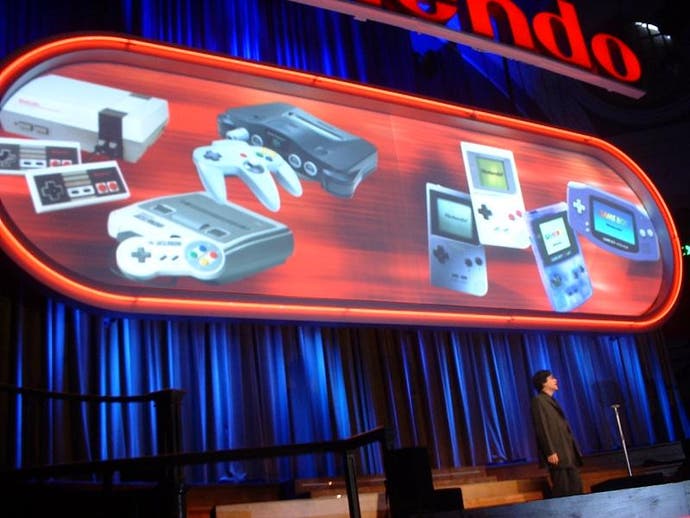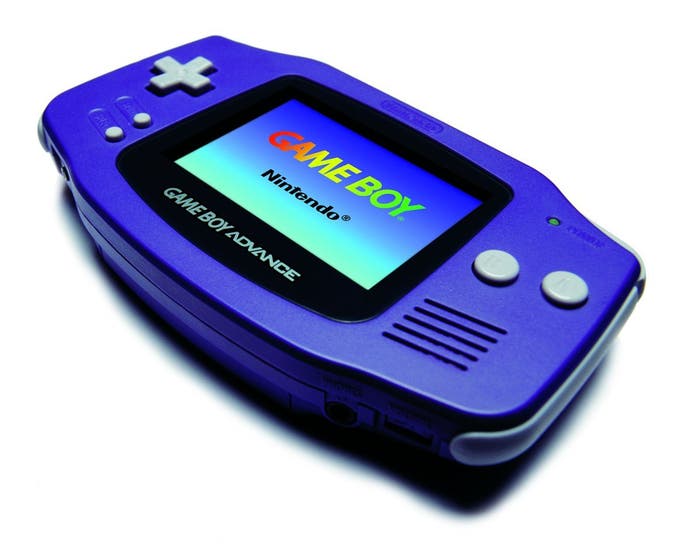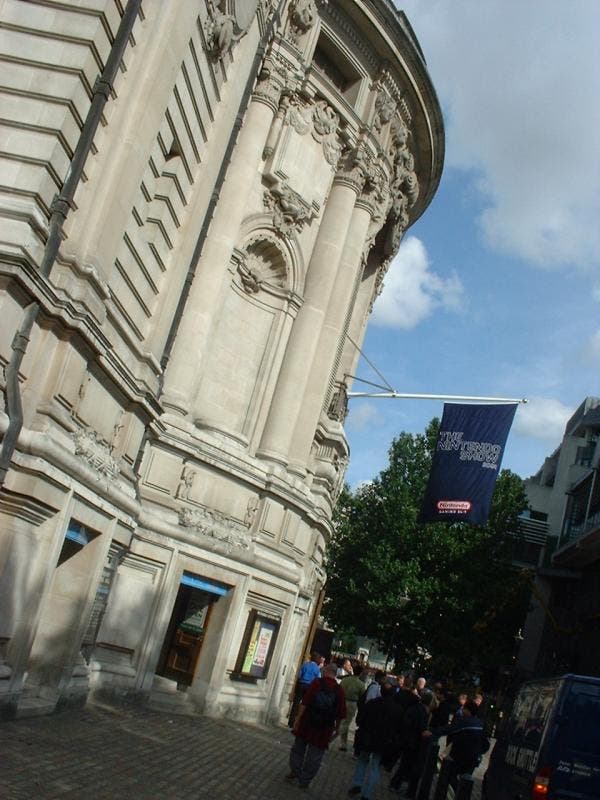The Nintendo Show
Article - EuroGamer is on hand to provide the world's first coverage of The Nintendo Show in London this afternoon, including the exclusive announcement of a new console!
For a year now, Nintendo have stimulated incredible retail performance in hardware and software. Today at The Nintendo Show in London, the suited figures of Satoru Shibata, Satoru Iwata and David Gosen explained how Nintendo had broken international sales records this year, and how it intends to transcend the borders between its consoles in the coming few. They also delivered the company's ongoing strategy - total dedication to gaming - to investors, retail chiefs and the press, outlining new initiatives that would appeal to gamers young and old. It was a heck of a show, with gospel singers leading us in and out to the tune of "Ain't No Mountain High Enough".

Looking Back
David Gosen's speech was the longest. An obvious salesman, he spoke smoothly and without notes as cameras flashed about him, illuminating the stage. It had been a sensational year, he gushed. In Spain, France and Germany Nintendo held a 50% of the console hardware market, and that looks set to rise to 70% before the end of September. It leads the software market too, and its success here is largely down to Pokemon. The third game in the famous series, Pokemon Yellow, was the fastest selling videogame ever and even made it into the Guinness Book of World Records. Between the months of October 1999 and April 2001, Pokemon games sold an estimated 15 million units. That's over 34,000 per week in Europe alone. When Pokemon Gold and Silver were released, they smashed all previous records, and Nintendo's predictions indicate between the two six million units will have been sold by Christmas. In terms of hardware, the GameBoy Color outsold every other platform, shipping 80,000 units per week. It continues to sell well. The GameBoy Advance, released here in June, obliterated all previous hardware sales records with half a million units inside the first week and millions more since, or as Gosen's PR spinsters have determined, approximately one unit every five seconds. The message is that the GBA has redefined handheld gaming and at the same time injected more sales into the retail sector. And amazingly, despite having to compete with its successor, the GameBoy Color has actually sold more units per month since the GBA was launched. A 4% increase in hardware sales, Gosen told the packed auditorium, and 3% in software.

Future Strategy
With so much activity in retail channels on both handheld fronts, Nintendo has had to revise its sales strategy on the go. It has now decided to market the GameBoy Advance to young adults and the GameBoy Color to what Gosen called the "entry level"; 11 years and below. This decision was made when it was determined that the average age of the GameBoy Advance owner was 18 years. There's a lot to come this year for the both consoles. Mario Kart Super Circuit, a game that we played extensively in the gameplay area after the show, will launch on September 14th, deflecting the interest of European gamers away from the Japanese launch of the GameCube. MKSC is nothing to be sniffed at; the company's biggest post-launch GBA game so far. In a survey of GameBoy Advance owners, virtually everyone knew about the game, and a staggering 70% said they intended to buy it. Sales projections indicate one million units will ship before the end of the year. Joining MKSC in the Christmas sales rush from November 7th will be Warioland 4 and Advanced Wars, both of which looked very impressive in the after-show gameplay area. In total, 40 games will be now available to Christmas shoppers. David Gosen also stuck up for the N64. Despite his colleague Mr. Iwata's comments to a Japanese newswire about the so-called failure of the platform, there was no hint of detachment as he spoke. Nintendo still view N64 as a core platform for gamers. As if to demonstrate this, he announced the pre-Christmas release of Pokemon Stadium 2, to be promoted by a European roadshow. As for GameBoy Color, what better than two new Zelda games to reinvigorate interest in the platform? Oracle of Ages and Oracle of Seasons will launch in November. A new Zelda adventure - so big it needed two games, the advertising slogan chimed through the huge speakers as we watched footage on the big screen. Younger gamers will of course latch on to the impending release of Pokemon Crystal, a game that will sell in stupendous quantities. And obviously, all of these games will also work with the backwards-compatible GameBoy Advance. Nobody has any excuse to pass them up. Gosen's message is that Nintendo has been selling well all year, it dominates hardware and software retail sectors… and you ain't seen nothing yet.
The Pokemon Company
After David Gosen strolled from the podium, the slightly shorter figure of Satoru Iwata replaced him. Beaming, the Japanese businessman announced in English; "Nintendo sees itself as gaming, while we're sure other companies see themselves as technology". Iwata has never had a problem with speaking his mind. He's all about the games, too. Gone was the financial spiel and hard sale of David Gosen. This was where the big news would come from. Bring on the goodies. First of all, Iwata told us, Nintendo wants to ensure the longevity of Pokemon. After such an extraordinary few years of growth, the company is concerned that people might stop caring; that kids might go elsewhere. To this end, the creative minds at Nintendo formed The Pokemon Company, a corporation dedicated entirely to concocting elaborate new toys to help entice young gamers. Not just games, but things like interactive trading cards, delivering new characters into the paws of GameBoy-owning youngsters, and even entirely new games. Not to mention a whole new, previously unannounced console. Card-E is the first part of Nintendo's strategy of "better gaming experiences." Gamers will buy the Card-E Reader, launching in Japan later this year and Spring 2002 in Europe, which slots into the cartridge area of the GameBoy Advance. Through Card-E, gamers will swipe new, barcode-bordered Pokemon trading cards. The barcodes, located on the left and bottom edges will comprise 2064 and 1296 bytes of data respectively. Card-E reads this data as you swipe. Swiping horizontally (1296 bytes) will release a new character, for use in Pokemon games, while swiping vertically (2064 bytes) will give youngsters a whole new mini-game. The more cards you buy, the more characters and games you will have. Buy a pack of ten cards and you're in games for a whole weekend. Buy some more after school on Monday and you're done for the week. And so on. Card-E will help bring kids more games, more often, and at cheaper prices, Iwata explained.

Pokemon Mini and GameCube
Next, Iwata pulled out Nintendo's biggest announcement of the Show; the launch of Pokemon Mini. Pokemon Mini is a tiny games console, a quarter the size of GameBoy Advance with a fully-fledged LCD, two buttons and the console will support its own games cartridges. On the top is an infra-red port with a 1.5m operating range for multiplayer functions. The console even has a rumble function. Even though it is still in development, four titles currently exist. Pokemon Mini is going to be cheap, we reckon. Iwata didn't say as much, but it's obviously a kid's toy, and a crafty one too. The IR will no doubt link with the IR not only on other Pokemon Mini consoles, but also the GBC and who knows what else, allowing Tamagotchi style character maintenance and more. By the looks of things, its size is in keyring territory, and once finished it will be aimed at young, young gamers and their slightly older GameBoy Color-owning brothers and sisters. Once Pokemon Mini was out of the way, Iwata spoke of GameCube. The "most efficient and gamer-friendly console ever," he told us. Launching as we already know on September 14th in Japan and November 18th in the USA, the console will complete an awesome gaming line-up from Nintendo. The European release date, which we had expected to hear about today, will actually be announced after the GameCube has launched in Japan and America. Although he claims he wanted to join us, gaming luminary Shigeru Miyamoto was not in London. His image was, though. Speaking through a video Miyamoto apologized for not attending; claiming that he felt he should stay home and finish up the GameCube's launch line-up. Nobody complained. He did want to introduce two of his most famous creations though. Mario and Zelda. Unfortunately, the video footage was the same as was filmed and leaked by journalists from Spaceworld a fortnight ago.

Making the Connection
The real joy of the show for this writer though was the demonstration of the GameCube / GameBoy Advance connection cable. We had heard rumours about Kirby's Tilt 'N' Tumble and how exciting it seemed at Spaceworld, but it's impossible to appreciate how ingenious the control method and console interaction really is without seeing it. The consoles are connected via a cable, which goes into a gamepad slot on the GameCube and the cartridge slot on GameBoy Advance. When both consoles are started, the GameCube spots the two metre cable connection and swaps data with the portable. The 'tilt' function is based on motion sensors within the cartridge element of the connector cable. Ever felt embarrassed leaning into a corner with your joypad while playing a racing game? Well prepare to do that for real. By tilting the controller forwards, the world tilts forwards, and Kirby rolls giggling and chirping towards some stars. The stars form a circle around some pinball-style bouncers. As the GBA is tilted right, the world slips away from Kirby and he turns, rolling around to collect the stars. It looked absolutely fantastic. Imagine, Iwata said, the possible applications. Snowboarding and skiing games will be revolutionized; racing games will benefit from a virtual steering wheel; footballers will be able to drop a shoulder and feign passing manoeuvres. It's going to be important. Beyond the obvious benefits of the motion sensor tilt function though, Kirby is also exemplary because it demonstrates the potential continuity between GCN and GBA. If Kirby falls from the winding platforms on the GameCube screen, he topples through space until he lands on your GameBoy Advance screen, from where you must locate someone to help him up to the top again, by throwing him! It's a genre-beater, really, and a very exciting concept.

Triumphant?
Returning to the podium while the audience collected its jaws from the floor, David Gosen concluded The Nintendo Show's presentation with the news that "the best is yet to come". Exclusives, and thinking outside of the box will propel Nintendo even beyond its own wildest expectations. As long as it's Gaming 24:7, it can't lose. Our overall impression? They're very confident, and by the looks of things have every right to be. The Pokemon Company has already delivered two interesting concepts which will stimulate thousands, perhaps millions of sales beyond the as-yet unreleased Pokemon Crystal, and thanks to the company's desire to transcend the boundaries between its platforms, more gamers are likely to buy more than one of its consoles. After the big presentation we were ushered into a gameplay area, where we viewed eight GameCube games and several GameBoy Advance and Color titles. Paper Mario (previewed elsewhere) and Pokemon Stadium 2 for N64 were on display as well. In terms of GameCube games, we were very impressed. All featured exemplary graphics and appeared to have the gameplay to match. We were lukewarm about NBA Courtside 2002, but that's more to do with our lack of basketball experience than anything else. Luigi's Mansion, perhaps the most prominent of the titles we were allowed to play, is every bit as good as it promised to be. Now viewed as something of a sideshow to the mythical Mario Sunshine, it shouldn't be, because it features some killer gameplay. Dazzling the ghosts with his flashlight, Luigi races for his Hoover, vacuuming up the mites before they can do him any damage. Elsewhere, Pikmin won the attention of many with its attention to detail and fascinating concept. Rogue Leader looked splendid, and Super Smash Bros. Melee looked mental. Eternal Darkness was eerie, promising some psychedelic gameplay enhancements, like the 'Insanity Meter', which when low can lead to weird hallucinations, like vanishing inventory items and less perceived health points than are actually available. As for Starfox Adventures, this was the first time space flight areas were available to press hacks, and they looked magnificent. Ducking and diving through fields of asteroids and hugging the surfaces of the larger ones, the daring Fox and his companions battle for the safety of a Dinosaur Planet. Completing the line-up, WaveRace Blue Storm demonstrated some of the most impressive water effects this writer has ever set eyes on. There is real depth, and the controls and gameplay are fantastic. Trying out two player there was no appreciable slowdown and things looked just as fantastic as played alone. The stunt mode caught more than its fair share of passing glances too. And did we mention the instant loading? Across the board?

Game Boy Advance
Gaming on the go is going to be more and more prevalent this year, especially now that the market leader has three consoles on the go. Moreover, it's finally decided to give us a proper Mario game on one of them. Now, that's not to say Super Mario Advance isn't a good game, but when you consider the fact that Super Mario Advance 2 features Super Nintendo smash hit Super Mario World and the original Mario Bros. game, you have to wonder why you spent all your pennies on the thing. Super Mario World is feature complete - we burned through about fifteen levels in quick succession, checking everything out, and visually and physically it's identical to the SNES version. The Mario Bros. part of the game wasn't functional at the show, but Mario World was more than enough. Beyond Super Mario Advance 2 we got the chance to try out Diddy Kong Pilot, using the tilt control! Flying little Diddy around the placeholder tracks arching and swirling the Game Boy Advance around in midair was surreal. The game itself doesn't look bad either. Our only concern with the tilt control has to do with the LCD. Given the lacklustre performance of the screen unless under direct light, is it entirely wise to develop a system of control based on angling the console? With any luck this won't be a problem, but it was noted that Nintendo had the GBA consoles piping display output to 14" Sharp LCD panels rather than allowing gamers to use the built in screen. Ironic perhaps, because Sharp may soon be dumped as manufacturer of Game Boy Advance LCD screens. Mario Kart Super Circuit, the final game we tried out, we have in fact been playing for weeks anyway using an import copy. We played along though, and it was nice to finally try out the four player multiplay function in the field, so to speak. It worked flawlessly. The game plays very nicely of course, and seems just as good as the Super Nintendo original, although it may have been the pixellated blow up that did it, but things looked simpler than we remember.

Conclusion
The Nintendo Show was an excellent day out. We can't imagine any of the press types on-hand going away and writing up a negative report. Satoru Shibata began proceedings by introducing us to "The Nintendo Show 2001", too. A meaningless tagline? It's more likely that we'll be heading back to London again same time next year, we reckon. One thing was certainly for sure; this was a darn sight more impressive than any ECTS stand we've ever seen, and we hope Nintendo stick to the formula. Yours, tired and giddy,
-

